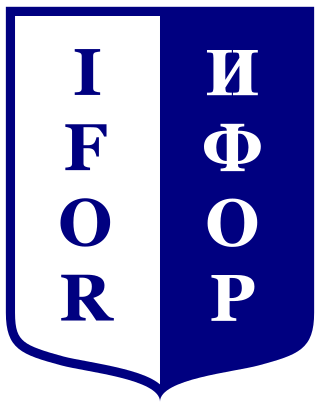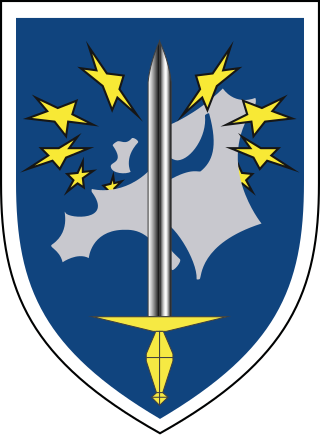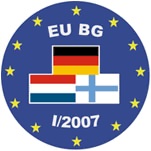
The Luxembourg Armed Forces are the national military force of Luxembourg. The army has been a fully volunteer military since 1967. As of December 2018, it has 939 personnel.

The Army of the Republic of North Macedonia is the military of North Macedonia. The army is organized, prepared and trained to conduct armed struggle and combat and other actions to achieve its constitutional function of defending the independence and territorial integrity of North Macedonia. The army consists of the ground forces and the air force, which are further divided into branches and services. The army has a permanent composition and reserve forces. Since 2005, it is a fully professional defense force compatible with NATO standards. On 27 March 2020, North Macedonia joined NATO as the 30th member.

A battalion is a military unit, typically consisting of up to one thousand soldiers commanded by a lieutenant colonel and subdivided into a number of companies, each typically commanded by a major or a captain. The typical battalion is built from three operational companies, one weapons company and one headquarters company. In some countries, battalions are exclusively infantry, while in others battalions are unit-level organisations.

The Implementation Force (IFOR) was a NATO-led multinational peace enforcement force in Bosnia and Herzegovina under a one-year mandate from 20 December 1995 to 20 December 1996 under the codename Operation Joint Endeavour.

The Weimar Triangle is a regional alliance of France, Germany, and Poland created in 1991 in the German city of Weimar. The group is intended to promote co-operation between the three countries in cross-border and European issues.

Eurocorps, located in the French city of Strasbourg (Bas-Rhin), is a multinational corps headquarters. Founded by France and Germany in 1992, it is today composed of personnel from six framework nations and five associated nations. The framework nations place the Eurocorps at the service of the European Union (EU) and NATO, which certified it in 2002 as one of its nine High Readiness Land Headquarters.

The Common Security and Defence Policy (CSDP) is the European Union's (EU) course of action in the fields of defence and crisis management, and a main component of the EU's Common Foreign and Security Policy (CFSP).

An EU Battlegroup is a military unit adhering to the Common Security and Defence Policy (CSDP) of the European Union (EU). Often based on contributions from a coalition of member states, each of the eighteen Battlegroups consists of a battalion-sized force reinforced with combat support elements. Two of the battlegroups were to be capable for operational deployment at any one time. The civil power that oversees these battlegroups is the Council of the European Union.

The Croatian Army is the largest and most significant component of the Croatian Armed Forces (CAF).
This is the Operation Herrick ground order of battle, which lists any British ground forces that have taken part in the duration of Operation Herrick between 2002 and 2014.

Battlegroup 107 or BG-107 is an EU Battlegroup. It originally consisted of military elements from the Netherlands, Germany, and Finland. From 1 January 2007 until 30 June 2007, it was on standby under German leadership. In preparation for its second standby period in the first half of 2011, when it was also known as EUBG 2011/1, its composition changed; Austrian and Lithuanian troops were added, the Netherlands took over command.

The 11 Air Assault Brigade is the rapid light infantry brigade of the Royal Netherlands Army, focused on conducting air assault operations. Troops of the brigade are qualified to wear the maroon beret upon completion of the demanding training course, those qualified as military parachutists wear the appropriate parachutist wings. The brigade received the name "7 December" when the First Division "7 December" was disbanded in 2004.

Lithuanian–Polish–Ukrainian Brigade "TLATAS" is a multinational brigade countries of the Lublin Triangle consisting of units from the Lithuanian, Polish and Ukrainian armies. Other countries are free to join the trilateral agreement. An agreement on its creation was signed on November 16, 2009. The brigade was to reach operational status in autumn 2011, but it was delayed; a January 2012 estimate put that date at some time in 2013. The unit was finally formed on September 19, 2014. In July 2015 the defense ministers of the three countries signed an agreement on the operation of the unit.

The 68th Special Forces Brigade was the unconventional warfare branch of the Bulgarian Armed Forces. It was an independent branch under the direct command of the Chief of Defence since February 1, 2017. Before that, the brigade was within the force structure of the Land Forces. It was one of two Bulgarian military special operations units, the second one being the Naval Special Reconnaissance Detachment, a combat frogmen unit, retained within the structure of the Bulgarian Navy. The 68th SF Brigade was transformed into the Joint Special Operations Command on November 1, 2019.

General Hans-Lothar Domröse is a senior German Army officer, former Commander of Allied Joint Force Command Brunssum.

EUBG 2014 II or EUBG 2014-2 is an EU Battlegroup consisting of around 3,000 troops from Belgium, Germany, Luxembourg, Spain, the Netherlands and North Macedonia. It was on standby from 1 July until 31 December 2014.

The Czech Land Forces are the land warfare forces of the Czech Republic. The Land Forces consisting of various types of arms and services complemented by air and special operations forces constitute the core of the Czech Armed Forces. Land Forces Command is located in Olomouc.

The current structure of the Royal Netherlands Army is as follows:

Enhanced Forward Presence (EFP) is a NATO-allied forward-deployed defense and deterrence military force in Northern, Central and Eastern Europe. This posture in Northern Europe through Estonia, Latvia, and Lithuania and in Central Europe through Poland, Slovakia and Hungary and in Eastern Europe through Romania and Bulgaria, is in place to protect and reassure the security of NATO's Northern, Central and Eastern European member states on NATO's eastern flank.

This article outlines the defence forces of the European Union (EU), which implement the EU's Common Security and Defence Policy (CSDP) in CSDP missions. There are two categories of EU multinational forces: ones that have been established intergovernmentally and made available to the CSDP through article 42.3 of the Treaty on European Union (TEU), such as the Eurocorps; and the EU Battlegroups, established at the EU level.

















